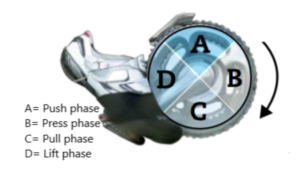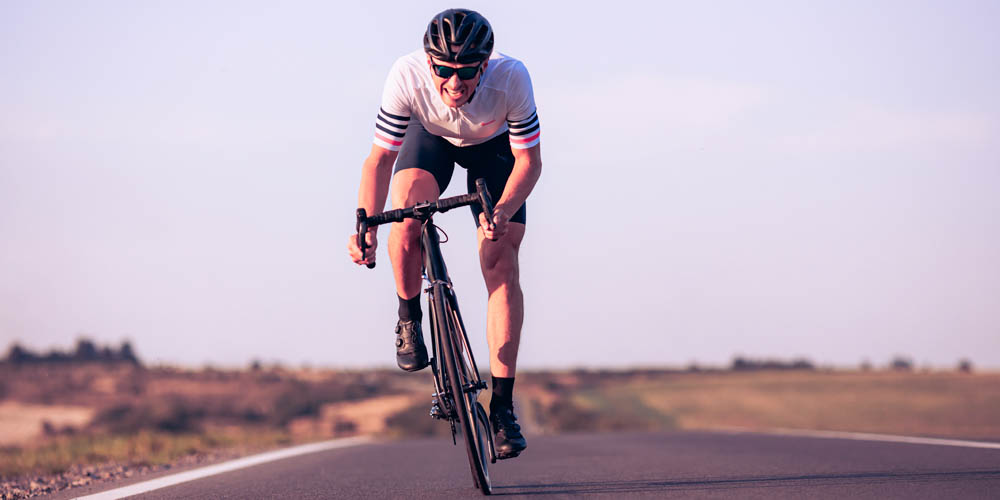Numerous studies have shown that an efficient and smooth pedaling motion can considerably reduce muscle fatigue and improve performance. However, such pedaling technique doesn’t come by chance but is the result of years of training. In this article, we present you with some helpful tips to enhance your pedaling technique.
Pedaling technique in cycling
For most cyclists, smooth pedaling involves applying force throughout the 360-degree pedal stroke. The phases of the upper transition (A), downward push (B), lower transition (C), and traction (D) offer many opportunities to generate power (these four phases are specific to cyclists with clipless pedals). In each phase of the movement, we observe the activation of distinct muscle groups that repeat in a continuous cycle.

Mastering an efficient pedaling technique requires a basic understanding and mental visualization of the correct foot position throughout the entire pedal revolution. This significantly facilitates learning and applying the correct technique. Here are some helpful tips to optimize your pedaling technique:
Circular Movement
There is often the assumption that pedaling, being a circular movement, occurs only in one direction.
However, this is not the case. Efficient pedaling is characterized by the even and steady application of force throughout the entire pedal rotation—both in the downward and upward movement. This method allows for maximum utilization of muscular force and reduces energy loss. Visualize pedal rotation as a circle and strive to rotate the pedal with your feet in the widest possible circles. Focus on the four key phases of the pedal cycle: push, press, pull, and lift.
Cadence Variation
Experiment with your cadence by alternating between very high and very low cadences. These cadence variations lead to an adaptation of your pedaling technique. Depending on the chosen cadence, the way you push and pull will change, which in turn solicits different muscle groups along the pedal cycle. Also, maintaining an appropriate cadence helps reduce irregularities in movement and ensures a smooth and continuous ride.
A high cadence contributes to improving intramuscular coordination. Get used to these high cadences and make sure to maintain an active pulling phase even at high frequencies.
Low cadences also have their value, as they promote strength endurance. During training sessions, try to pedal continuously on long moderate climbs with high gears and a cadence of about 60-70 rpm. Always stay seated while doing so.
Examples of exercises:
- Increase the cadence by 10 rpm every minute.
- Maintain a specific cadence over a longer stretch. To do this, you need to shift gears frequently – and thoughtfully – or increase effort, depending on the terrain.
- Start at a normal speed, then pedal as fast as possible for 30 seconds. This method will help gradually increase your maximum cadence.
Single-Leg Exercises
For optimal pedaling technique, it’s essential to distribute equal power to both legs while pedaling. This balance in distributing effort during the pedal stroke is crucial for the efficiency of your ride. It’s important that both legs are equally strong. So, don’t neglect exercises that focus on one leg.
An example of an exercise is single-leg pedaling: on a stationary bike, pedal exclusively with one leg for a predetermined period, such as 30 seconds or 1 minute, then switch to the other leg. Then, reposition both feet on the pedals and resume pedaling. You can repeat this exercise several times. The advantage of single-leg pedaling is that you must execute the four phases of the pedal stroke flawlessly to continue pedaling. It also helps improve balance and develop strength and coordination.
Utilizing the Right Muscles
A smooth pedaling technique involves the efficient use of leg muscles, focusing on the appropriate muscle groups to maximize power and reduce fatigue.
- Upper Transition Phase: The primarily involved muscles are the hip flexors, which help lift the leg and apply slight pressure on the pedal to prepare for the downward push phase.
- Downward Push Phase: In the push phase, the cyclist achieves maximum power. The quadriceps are primarily used to exert downward force on the pedal while maintaining constant pressure. The cyclist extends the hip and knee, while the ankle dorsiflexes the foot. Even monoarticular muscles like the gluteus maximus and vastus are activated, generating power.
- Lower Transition Phase: At this point, the hamstrings and calves are engaged to prepare for the upward pull phase.
- Upward Pull Phase: Involves the muscles of the hamstrings, calves, and hip flexors to pull the pedal upwards and complete the pedal stroke.
Optimizing Bike Fit
A well-fitted bike is probably the most important factor that will enable you to improve your pedaling in the short term. The saddle position has a direct impact on your pedal stroke and the power you can generate. Even a minor change, such as 2%, results in a significant efficiency alteration.
Saddle height directly affects your ability to keep the pedal level during the push phase and prevents harmful positions like pedaling on the tip or heel, which can cause joint issues. Adjusting the saddle setback determines the knee position, which, like the foot, finds the best compromise in alignment with the pedal axis.
Trunk Positioning and Training
Maintaining a proper position on the bike, with good weight distribution and ergonomic posture, promotes a smooth and efficient pedaling motion. Training the upper body is very helpful in maintaining a good position on the bike.
Create a training plan for triathlon, cycling, and running based on artificial intelligence with 2PEAK that adapts to your performance after each training session. Download the app and start revolutionizing your training.


